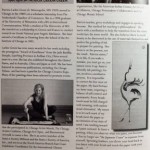Art meets meditation in the ancient Asian technique of ink wash painting. A contemporary award winner will show how it’s done when the Lemont Artists Guild presents a demonstration by Patricia Larkin Green.
Japanese Culture Center – 日本文化会館
2016.8.4: Japanese Culture Center – 日本文化会館: Introduction to Sumi-e Course
中国遼寧分会後援会賞 Award from China
, Invitational, AnShan City– “ICCPS (International Chinese Calligraphic Art and Ink Painting Society)”, AnShan City, China invited by Society Founder, Ransui Yakata-2015
Honored to receive 中国遼寧分会後援会賞 Award from AnShan City China ICCPS Invitational
Lemont Artists Guild draws top talent for lecture
Lemont Artists Guild to draw on top talent for lecture: Award-winning Larkin Green to demonstrate ink wash painting
(Photo provided by Laurie Peacock and Maggie Rife Ponce)
Sumi-e Ink Ensō Painting demonstration and workshop
Japanese Cultural Center: Nov. 7th, 2015-12:30 Enso Demonstration & Workshop
Scrolls from both the Nakashima Collection and the private collection of the JCC will be on display in addition to Ikebana flower arrangements.
Additionally, an ensō demonstration and sumi-e workshop by Patricia Larkin Green, sumi-e artist, who will demonstrate painting ensō and lead participants in meditation before practicing their own ensō at 12:30 PM on Saturday. The Artist will provide hands-on guidance and discuss a brief history of the ensō (a hand-drawn circle in one uninhibited brushstroke to express a moment when the mind is free to let the body create).
Read More»AnShan City China Exhibition
2015.10.1-10: I am honored to share recognition with esteemed artists of the North America Branch – ICCPS . I have been notified that I have received the 中国遼寧分会後援会賞 Award in AnShan City China for the 2015 exhibition.
Chicago Tribune: Sumi-e Asian Ink Painting
Sumi-e Ink Painting
Three Dahlias One Bee Sumi-e by Patricia Larkin Green
Patricia Larkin Green will demonstrate Sumi-e Ink painting. She is well known as a painter along with her skills in sumi-e ink painting. A turning point for her was learning to paint Sumi-e, (East Asian ink wash painting), where her goal is to capture the soul of the subject. When she paints a flower she is freed from reproduction and inspired to convey its movement and fragrance. Less is more. Her website is: patricialarkingreen.com.
i dreamt i was a butterfly sumi-e painting by Patricia Larkin Green
How do we know if life is not an illusion…
and what difference does it make?
Chuang Tzu, a contemporary of Mencius, is universally regarded as the greatest Taoist after Lao Tzu. His butterfly dream is probably the most celebrated dream ever to be recorded in the history of Chinese Philosophy, which makes it almost impossible to omit in any serious expositions of Chuang Tzu’s works. Whether or not the dream actually occurred is not a matter of great importance. What is important is that it has captured the minds of generations of Philosophers
Chuang Tzu, however, preferred something more compromising: “When I say you are dreaming, so am I.” In other words, we are all dreaming. This is best illustrated in his butterfly dream story. ‘The passage:
Once upon a time, Chuang Tzu dreamed that he was a butterfly, flying about enjoying itself. It did not know that it was Chuang Chou.
Golden Dream poem and ensō by Patricia Larkin Green Artist
Golden Dream poem and ensō by Patricia Larkin Green Artist
Elliptic Dream
Condense. Seep.
quench quaking roots…
Come.
Golden Magnanimity
illuminate earth
Sumi-e Society of America featured artist Patricia Larkin Green
“Patricia teaches, gives workshops and engages in speaking formats. Her method for teaching is philosophical. She starts with a meditation to help the transition from the outer world into the inner world. She also believes there is much beauty to be discovered in the use of materials themselves and prefers grinding her own ink to prepare for painting. Her focus is on the process, not the result. Patricia states,” As in life, if you make a mistake, you must go on, you cannot cover it up. Sumi-e (literally ink painting), for me, involves a meditative process. It is impossible to correct the line once on the paper. My hand betrays my inner state, requiring a balance of self-control and spontaneity. Every brush-touch must be fully-charged with meaning, with useless detail eliminated. My intent is to let each mark of my brush meet the paper as an extension of my state of mind. I am working inward as I paint outward. In Sumi-e painting, when you observer what you paint, you become it. You no longer see “the Japanese Crane” as separate from yourself. Sprouting feathers, you throw your head back as you dance with your brush and touch the paper with your breath….””









